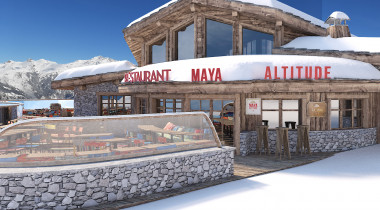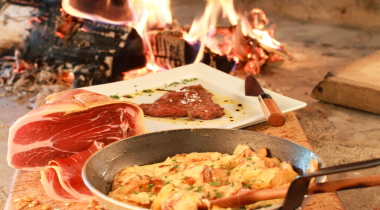23.07
2012
Gastronomy
This viticulture, which is carried out at altitudes of more than 500m or on steep slopes of 30% or more, can only be described as heroic.It requires a much greater involvement from the winegrower than on the plain.
An old occupation
In the past, the plains with their rich soils were reserved for wheat and barley.The hillsides, steep slopes and higher altitude plots - poor arable lands – were entrusted to a resistant plant.This plant, which can grow even in poor soil, was the vine!
Chronicle of a relocation
This viticulture, which is carried out at altitudes of more than 500m or on steep slopes of 30% or more, can only be described as heroic.It requires a much greater involvement from the winegrower than on the plain.
An old occupation
In the past, the plains with their rich soils were reserved for wheat and barley.The hillsides, steep slopes and higher altitude plots - poor arable lands – were entrusted to a resistant plant.This plant, which can grow even in poor soil, was the vine!
Chronicle of a relocation
The phylloxera pest arrived from America.This louse, which sucks vine roots, destroyed the vineyards from South to North in only a few years.There were wine shortages; notreatment was effective.The only solution wasrootstock.The vineyards were replanted, but only on the plains where vines produce more and faster.The abandoned banks, terraces and levees watched the spread of the vine "fields”.
The pendulum of supply and demand
The first episode of overproduction took place at the beginning of the 19th century, resulting in a drop in prices.During the First World War, the soldiers drank wine, but no longer maintained the fields.Mechanisation saved the period between the wars and chemistry contributed to the production growth required by the high productivity policies after the Second World War.
But the price of wine did not allow for replanting the slopes.Besides, no one would even have considered doing it!
You would have to be mad
Who would want to cultivate the steep slopes?This viticulture requires some 600-650 work-hours per hectare for even the easiest areas.This can increase to 2000 hours / hectare for the arduous plots, for a meagre yield due to climatic conditions and the thin topsoil layer.On the plains, mechanisation helps winegrowers, who only need a hundred or so hours for the same hectare and for much higher yields.
Reinstallation
However, some “madmen” took up the small family plots, the few acres cultivated by the uncle or the few rows which were so valued by our ancestors, but we didn’t know why.
At the beginning of the 1980s, interest grew in these terrains which were challenging but which produced a different quality wine. At the same time, the increase in the price of wine allowed the business to develop.
The winegrower as landscape architect
Today, many of the long-abandoned plots have been rehabilitated.The countryside has regained its landscape design and its history.
In addition, the maintenance of the slopes is an essential asset for the conservation of mountain zones and steep slopes - which are strong but fragile territories.
Near Mont Blanc, Ayze
The Alps are packed with slopes and cliffs.Vines flower on some steep slopes, which are choice - often very sunny - locations, where the grapes manage to grow. Well- or less well-known, these rare wines even sometimes capture the plant's originality, such as the Gringet in Ayze.
The Ayze “appellation”, at 450m altitude, is one of the 22 Savoyard wines, although it only represents 2% of the production. Only 22 hectares are dedicated to the Gringet, which comes in sparkling or still wines.
Savoie, serenade the Altesse until you are dizzy
The Marestel wine (pronounced without the ‘s’), is dedicated entirely to this grape variety.West-facing, it occupies the foothills of the Charvaz, facing the Bourget Lake opposite.
Practically abandoned up to the 1990s, Marestel is today cultivated on more than 30 hectares.Very steep - more than 60% in places – it offers its marl-limestone soil to the closely packed rows of Altesse vines, planted at 10 000 vines / hectare.
Basque wine, Irouléguy
Coming from the Atlantic, at around 50 kilometres from Biarritz on the Pampelune road via the Nive, Irouléguy has made its enclave in the Pyrenean foothills.
Irouléguy occupies a surface of around 200 hectares.It rains 1500 mm per year, with an average temperature of 13°C but the harvest enjoys renewed heat when the winds from Spain warm up with the “Foehn” effect.
Bugey, Ain in the South-East
The Vins du Bugey "appellation” covers around 500 hectares between Bourg-en-Bresse and Chambery.Its Jurassic geology has subdivided the soil into red soils for the Cerdon, marl and limestone scree for Montagnieu, limestone and moraine glacis for Belley.
Gentle mountain bubbles, the Clairette de Die
The Drôme, a tributary of the Rhône, narrows on approaching Die and the foothills of the Vercors.Here is born the Diois vineyards, filled with a multitude of plots.They climb to 700 m in altitude, thus benefiting from the best exposure.
Jura, Château Chalon
The "appellation” area covers around 50 hectares planted with Savagnin, the grapes of the Vin Jaune (or “Yellow wine”).Four communities – Ménétru-le-Vignoble, Domblans, Château Chalon and Nevy-sur-Seille - lend their steep south or south-west facing hillsides, with gradients of more than 45% in some places, climbing from 250 to 400 metres.
The Rangen of Thann, South Alsace
A few dozen kilometres after Colmar, the Wine Route curves to the right to follow the Thur valley.The countryside changes as the hills of Cernay are forgotten, and your eye is drawn to the steep slopes which dominate the river between Vieux-Thann and Thann.
The most southerly of the Alsace “grands crus” occupies a privileged “terroir” - avolcanic soil on a vertiginous slope reaching 90%.
Marc Vanhellemont





